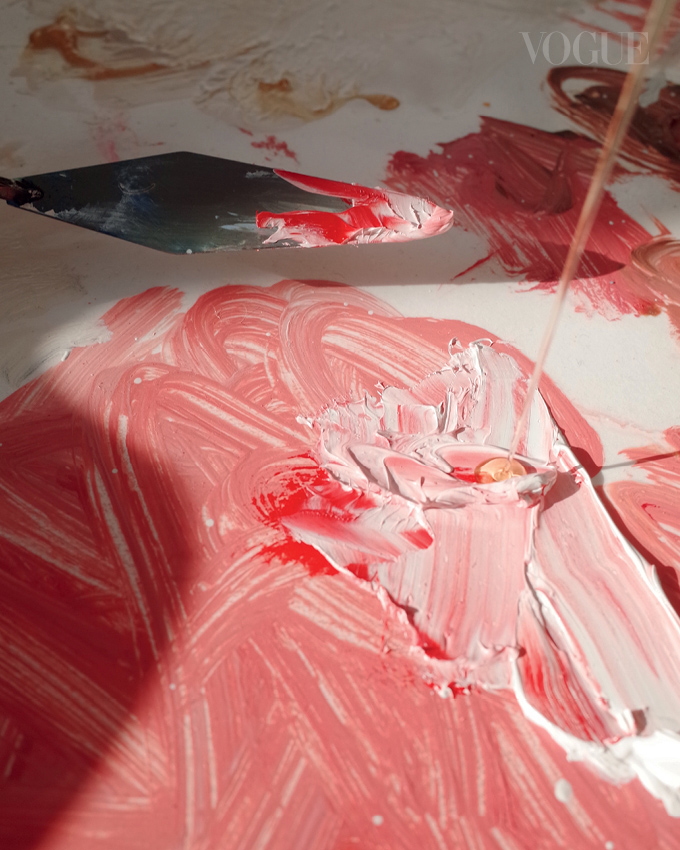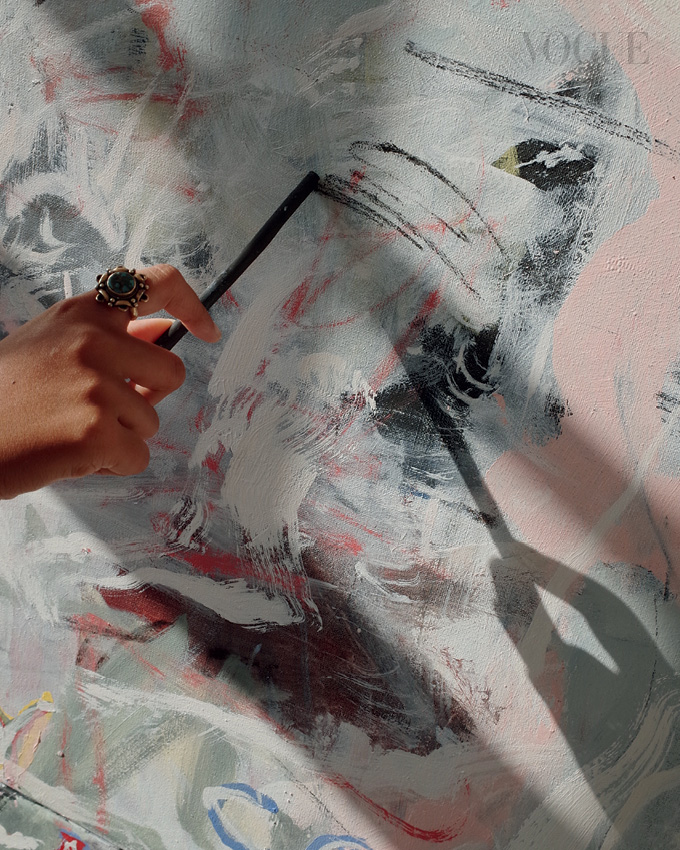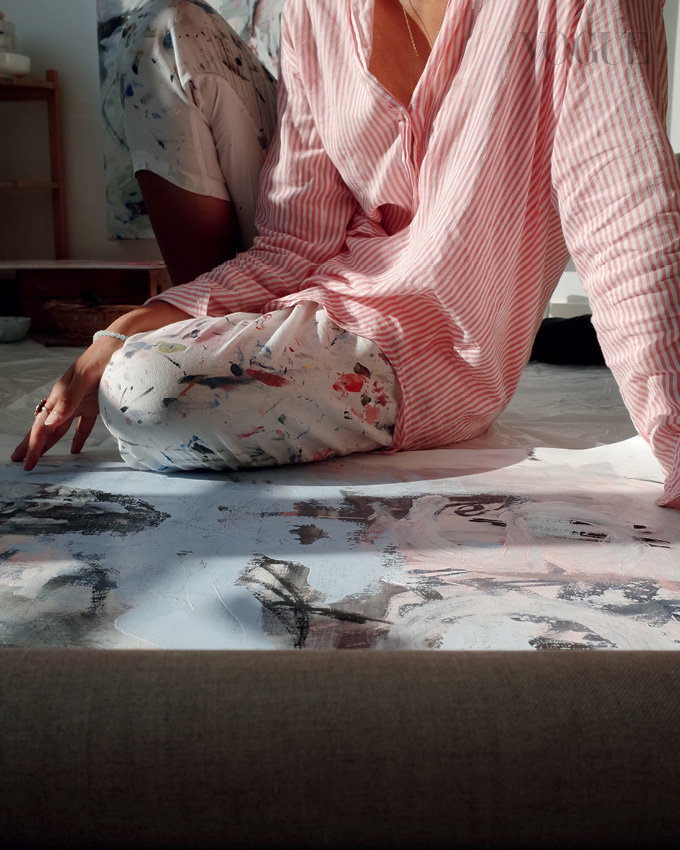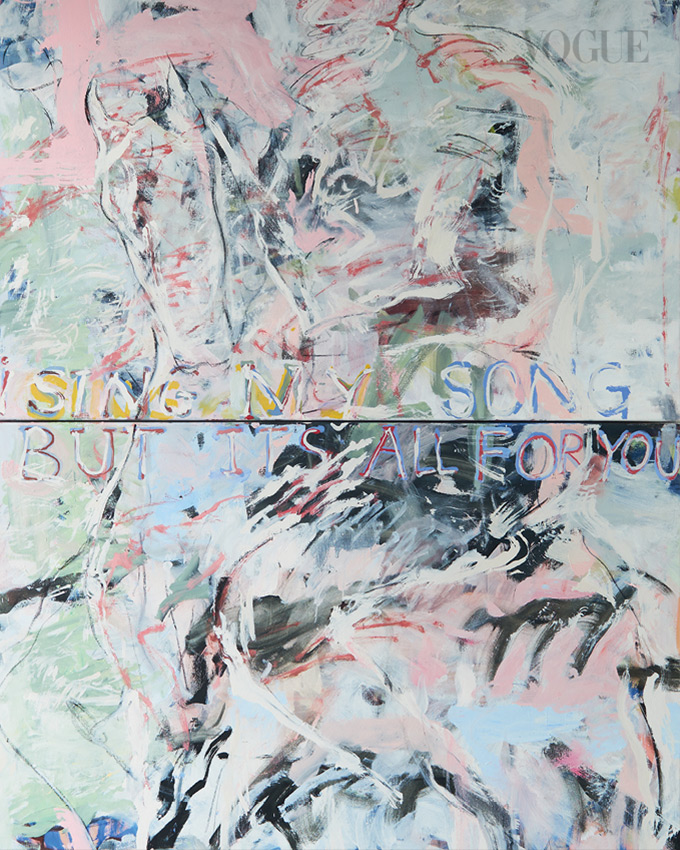Vogue artist-in-residence Natisa Jones reflects on what it means to be a dreamer in a time of anxious uncertainty
5 October 2021
Balancing intimacy with universal truths, artist Natisa Jones seeks to understand the dynamics between people and their contexts through her work, asking life’s biggest existential question—why are we here?
Originally Javanese but raised in Bali, artist Natisa Jones is quite the globetrotter. Having spent many years studying overseas in Thailand and Melbourne, she now paints out of Amsterdam—a serene city known for its elaborate canal system and artistic heritage.
For Jones, a career as an artist was a natural progression that began in early childhood. “I am an only child,” she explains, “so I grew up on my own a lot; drawing was a way for me to deal with whatever was around me.” This evident artistic inclination was nurtured by her mother and grandmother, who are also creative individuals, and they encouraged her every step of the way. When it came time to decide her career trajectory, well, it’s safe to say it truly was a no-brainer.

Her artistic curiosity has long laid in the human condition and through her work she strives to uncover the similarities in our experiences that connect us, despite our differences. In her piece for Vogue Singapore, this concept extends to an exploration of what it means to be a dreamer during a time of anxious uncertainty. Weaving together opposing themes of tension and a sense of unity, she aptly bridges the gap in the form of a diptych.
Jones’s next project? A solo show at Hatch Art Project in Singapore from 23 October entitled ‘Despite the Havoc’.
What does being a dreamer mean to you?
For this particular project, I was thinking about what it meant to be a dreamer in a time where things feel a bit dim. To me, being a dreamer is synonymous with being connected to a hopeful state; a childlike belief that things are worth doing for the good. When the pandemic hit, I was having a tough time painting because everything felt quite bleak. But in hindsight I think it was a good moment. I had to pause and think to myself, “How can I do more than just survive? How can I romanticise about the future?”
I thought a lot about my grandmother during this time. She has always been a huge inspiration in my life. She also happens to be an incredibly creative person. When my grandmother was in her late forties, she lost her husband and had to raise four children on her own. Yet despite everything, she was such a happy person. The take away from this anecdote is, how do you move on and find the love in life when difficult things happen? This, to me, is true romanticism; doing things to bring joy to others, and it turn, bring yourself joy.
“To me, being a dreamer is synonymous with being connected to a hopeful state; a childlike belief that things are worth doing for the good”
That’s a lovely sentiment.
Well, sometimes in art, especially now with social media, everything feels very self-focused. People what to know what you are making and it if it is all about you, but at the end of the day, it’s not. I think that one of the ways to keep things in perspective is to create for other people, to me that is the whole point. When you take the time to do something for someone else, you just don’t have the time to dwell on how hard something is, especially if it is for someone you love.
I mean, what is truly personal anymore? What is performative and what is my genuine vulnerability? These are still thoughts I am trying to figure out.

Your creations mesh painting with text—how did this become part of your artistic identity?
Conscious or unconscious, it comes down to the fact that writing is naturally a part of my process. My grandmother was an avid writer, and when she experienced her loss, she began writing poetry. I still have these poems today; perhaps I get this need to express myself using words from her.
This written mode of self-expression is very therapeutic for me and organically found its way into my paintings. When I add a text, it serves as another narrative and the two narratives, text and painting, speak in different ways. It helps to redirect people’s thoughts, keeping the ideas evoked by my work moving and adds a sense of tension and duality.
Could you talk us through the creative process behind your piece for Vogue Singapore?
Most of my work is about the human condition. As I mentioned earlier, I am interested in people, relationships and figuring out why we are here. So I write a lot, every day actually. On days that I’m not writing, a loose sentence will find its way onto my phone. Even when I’m not working, I am constantly thinking about it. These thoughts accumulate in a kind of functioning chaos, I curate these moments and eventually they end up on canvas as a final piece.

The pandemic has impacted us all in one way or another. How has the situation influenced you and how are these sentiments conveyed in your work?
I do feel as though my work has shifted as a result of the pandemic, because the way I look as the world has changed. Before COVID, a lot of my figures had very prominent faces, now they are more obscure, broken down and in motion. Little things like this intuitively find their way into my pieces and informs me about how I am feeling.
Introspection and reflection have a strong resonance in your work, including this one. Could you elaborate on that?
When Vogue told me that the edition was about dreamers, I was trying to reconcile what it means to dream and be hopeful. Something I was having a hard time doing personally. For me, it came back to the story of my grandmother; a need to go beyond individualism to see the bigger picture.
The spark that started this piece came from a phrase that kept running through my mind, ‘I sing my song but it’s all for you’. That is the central idea here. As an artist who creates very personal work, I have insecurities about people perceiving my art as centred on the self. This is absolutely not the case. The point of the work is that I am sharing a vulnerability that hopefully the viewer can resonate with.
This is where the concept of the diptych originated. Where the piece says ‘I sing my song but it’s all for you’, the panels can be separated into two pieces. One half is something that I start with, my vulnerability, but in the end it’s all for you, as shown by the second panel. Ultimately it’s about creating a conversation, without a receiver my expressions don’t mean much. What I am asking is, is there anyone out there who feels the same? Is this something we have in common? If not, I want to know why? The point is not to agree, but to have a dialogue and exchange. This is where the idea of introspection and reflection come from, it allows me to contextualise myself within the scope of the people around me.

Did you know from the offset that your work was going to comprise of two separate canvases joined as one?
No, it started off as two pieces, but when I was making it, it just didn’t feel right and I was having a difficult time keeping the panels separated. When I put the two together, it created a sense of tension and at the same time, unity. The disconnect that comes from this division is very important. It reflects the disconnection I felt about a lot of things at the time and the two pieces coming together allowed me to reconcile these feelings. It was an ‘aha’ moment. Suddenly, it made sense and metaphorically it clicks in nicely with the notion of give and take, which is central to the work.

What is your dream for society?
I can only really make art, and I can only really change moments for people in small doses and hopefully that is meaningful enough. Personally, I am passionate about advocating for mental health awareness. This is why I make space for emotional journeys in my work. Our anxieties and vulnerabilities are thoughts we need to be able to express regardless of personal background, it’s something that unites us all.
A lot of the time my figures are genderless and this is why. Your context, be it skin colour, gender, or sexual orientation is not the focus here. We all feel pain, we all feel joy, we all go through the same emotions in different designs and capacities. I want to talk about what connects us all. I want a 15 year-old girl or 50 year-old man to look at my work and have an emotional response to it, that’s my goal and what drives me.

Credits
Photographer: Olivier Turpin
Videographer: David Joosten




